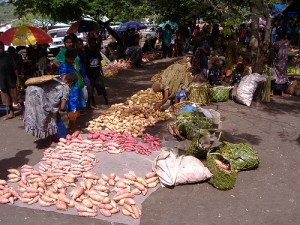Amazingly, there are people out there who can name a sweet potato variety at twenty paces. And in a photograph. Check out the comments to a recent flickr upload of mine showing a market in Rabaul. Now, if only I had geo-referenced it…

Agricultural Biodiversity Weblog
Agrobiodiversity is crops, livestock, foodways, microbes, pollinators, wild relatives …
Amazingly, there are people out there who can name a sweet potato variety at twenty paces. And in a photograph. Check out the comments to a recent flickr upload of mine showing a market in Rabaul. Now, if only I had geo-referenced it…

Bioversity’s Michael Mackay was recently interviewed on Radio Australia about plans to lead us all out of genebank database hell. Good luck to him!
 News just in of a film competition. Trouble is, entries close on 31 January 2009. So, you’ve either already made the film, or you are a seasoned professional who can crank out finished product in 10 days or so. Either way, we say: “Go for it”.
News just in of a film competition. Trouble is, entries close on 31 January 2009. So, you’ve either already made the film, or you are a seasoned professional who can crank out finished product in 10 days or so. Either way, we say: “Go for it”.
Film-makers and new media artists across the Asia Pacific region are invited to enter their audio-visual creations for this award recognising excellence in films on rice-related issues. Presented by Pesticide Action Network Asia and the Pacific (PAN AP), TVE Asia Pacific (TVEAP), and Public Media Agency (PMA) of Malaysia, the competition is open to both fictional and factual films on the theme of Asia’s rice heritage and the threats it faces in this era of globalisation.
The films may have been produced using professional video, home video, mobile phones or cinematic equipment. They may be in any of these formats or genres: 2D animation, 3D animation, songs, short drama, satire, adaptations of folk culture, or documentary. They need to have been made after January 1 2008. The winner will receive US$2,000, a plaque, and a certificate.
Blurb from Communications Initiative. Full details from PAN AP’s web site. Can’t think why they didn’t think to publicise the competition through us.